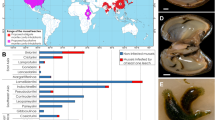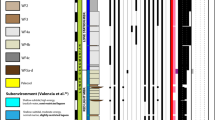Abstract
Symbiont-containing mussels (Mytilidae) are found at hydrothermal vents and cold seeps on the ocean floor, but it is not known whether these taxa represent an ancient lineage endemic to these surroundings or are more recent invaders. Here we show that several small and poorly known mussels, commonly found on sunken wood and whale bones in the deep sea, are closely related to vent and seep taxa, and that this entire group is divergent from other Mytilidae. Our results indicate that vents and seeps were recently invaded by modern mytilid taxa and suggest that decomposing wood and bone may have served as ‘steps’ for the introduction of mytilid taxa to vents and seeps.
This is a preview of subscription content, access via your institution
Access options
Subscribe to this journal
Receive 51 print issues and online access
$199.00 per year
only $3.90 per issue
Buy this article
- Purchase on Springer Link
- Instant access to full article PDF
Prices may be subject to local taxes which are calculated during checkout

Similar content being viewed by others
References
Kenk, V. C. & Wilson, B. R. Malacologia 26, 253–271 (1985).
Gustafson, R. G., Turner, R. D., Lutz, R. A. & Vrijenhoek, R. C. Malacologia 40, 63–112 (1998).
Deming, J. W., Reysenbach, A. L., Macko, S. A. & Smith, C. R. J. Microsc. Res. Tech. 37, 162–170 (1997).
Bennett, B. A., Smith, C. R., Glaser, B. & Maybaum, H. L. Mar. Ecol. Prog. Ser. 108, 205–223 (1994).
Smith, C. R., Kukert, H., Wheatcroft, R. A., Jumars, P. A. & Deming, J. W. Nature 341, 27–28 (1989).
Dell, R. K. Natl Mus. NZ Rec. 3, 17–36 (1987).
Hillis, D. M. & Bull, J. J. Syst. Biol. 42, 182–192 (1993).
Leschine, S. B. Annu. Rev. Microbiol. 49, 399–426 (1995).
Grassle, J. F. & Morse-Porteous, L. S. Deep-Sea Res. 34, 1911–1950 (1987).
Reid, R. G. B. Can. J. Zool. 58, 386–393 (1980).
Dando, P. R., Southward, A. J. & Southward, E. C. Nature 356, 667 (1992).
Feldman, R. A., Shank, T. M., Black, M. B., Baco, A. R. & Smith, C. R. Biol. Bull. 194, 116–119 (1998).
Dean, H. K. Malacologia 35, 21–41 (1993).
Wolff, T. Sarsia 1, 117–136 (1979).
Campbell, K. A. & Bottjer, D. J. Geology 23, 321–324 (1995).
Swofford, D. L. PAUP* 4.0 (Phylogenetic Analysis Using Parsimony) (Sinauer, Sunderland, MA, 1997).
Distel, D. L. Mol. Phylogenet. Evol. (in the press).
Author information
Authors and Affiliations
Corresponding author
Rights and permissions
About this article
Cite this article
Distel, D., Baco, A., Chuang, E. et al. Do mussels take wooden steps to deep-sea vents?. Nature 403, 725–726 (2000). https://doi.org/10.1038/35001667
Issue Date:
DOI: https://doi.org/10.1038/35001667
This article is cited by
-
Mitochondrial genomic analyses provide new insights into the “missing” atp8 and adaptive evolution of Mytilidae
BMC Genomics (2022)
-
Characterisation of the enzyme transport path between shipworms and their bacterial symbionts
BMC Biology (2021)
-
Mussel biology: from the byssus to ecology and physiology, including microplastic ingestion and deep-sea adaptations
Fisheries Science (2021)
-
A relict oasis of living deep-sea mussels Bathymodiolus and microbial-mediated seep carbonates at newly-discovered active cold seeps in the Gulf of Cádiz, NE Atlantic Ocean
PalZ (2021)
-
Biological rhythms in the deep-sea hydrothermal mussel Bathymodiolus azoricus
Nature Communications (2020)
Comments
By submitting a comment you agree to abide by our Terms and Community Guidelines. If you find something abusive or that does not comply with our terms or guidelines please flag it as inappropriate.



